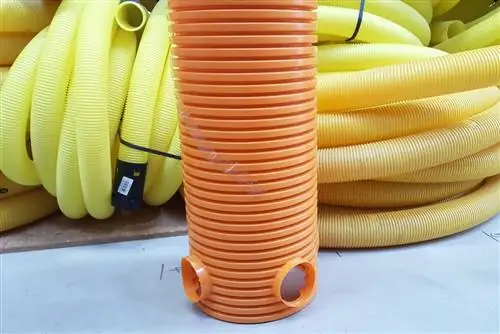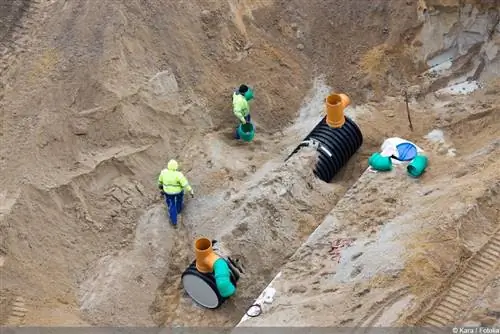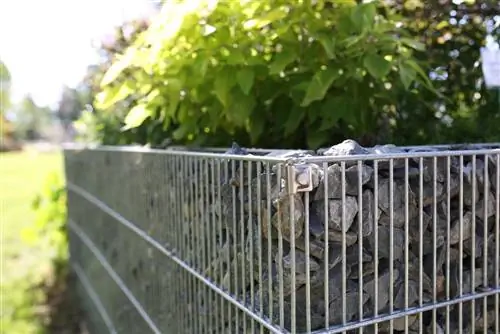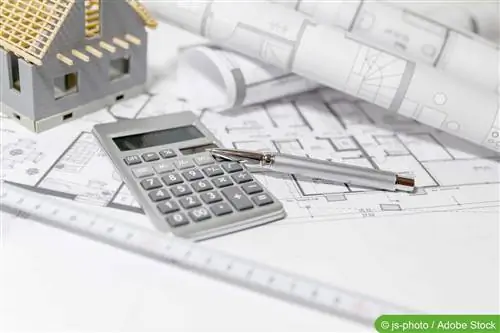- Author admin [email protected].
- Public 2023-12-17 03:39.
- Last modified 2025-06-01 06:48.
Increasing compaction on ground surfaces, increased heavy downpours and closed areas of earth caused by asph alt and stone paths, for example, make it more difficult for rainwater to drain away and promote flooding. More and more property owners are opting for a septic tank into which the water can be directed and drained away. How you can build a seepage shaft yourself and what you have to pay attention to is explained in detail in the following instructions.
Approval
The construction of septic tanks is subject to approval in most regions. This must be obtained from the responsible water authority. There you will find additional information about regulations that you must adhere to when building a septic tank in order not to violate legal regulations.
Approval requirements
Official regulations relate, among other things, to the local conditions of the future location of septic tanks. They are generally not permitted in water and spring protection areas as well as on properties where contaminated sites can be proven. Exact information on each individual case can be obtained from the responsible authority.
In addition, a permit requires that there is a minimum infiltration capacity of the soil. This usually relates to the existing soil conditions. Heavy clay soil, for example, allows water to seep away slowly. Loose, gravelly soil, on the other hand, is well permeable to water. For this reason, it is important that you choose the location for your seepage well before you apply for a permit, which will also help you with a good drainage option.
Measuring infiltration performance
You can easily determine the infiltration rate yourself. To do this, proceed as follows:
- Dig a hole measuring 20×20 centimeters high and wide and 40 centimeters deep
- Level the hole base and cover it with coarse sand or gravel about two to four centimeters
- Pre-water the pit hole continuously for one hour - it must not be left dry
- Attach the ruler to a stick and stick it into the pit
- Fill the pit once with water to about half the depth of the pit
- Measure and note the water level immediately
- Retake water level measurement after 10 minutes, 30 minutes and after 60 minutes
Calculation example:
If two centimeters of water seep away within ten minutes, this amounts to 12 centimeters over an hour. This results in an infiltration rate of 120 liters per square meter for the example mentioned.
Seepage shaft calculation
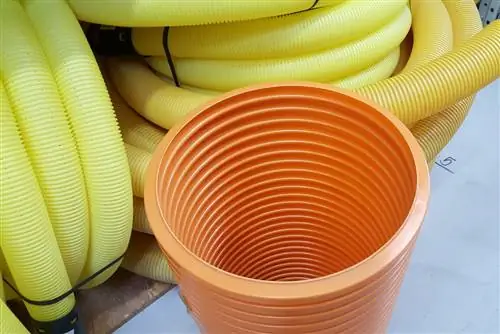
Which dimensions septic tanks should/must have so that they fulfill their purpose satisfactorily and/or there are no problems with the authorities depend on various factors.
Groundwater table
The groundwater level plays an important role in the calculation. As a rule, municipal or city regulations stipulate that there must be a distance of at least one meter from the bottom of the shaft to the groundwater table. For example, you can often find out the current groundwater level in the region of the property from well builders in the area. The State Office for Nature, Environment and Consumer Protection, LANUV for short, regularly updates groundwater level data and can also provide you with the data.
Rain amount
The infiltration performance depends, among other things, on the amount of rainwater that should flow or be directed into the infiltration shaft. The statistically recorded annual rainfall averages in connection with the rainwater area are particularly important here. These values vary from region to region.
Calculation example
2017, for example, the average value in Saarland was 990 liters and in Saxony-Anh alt it was “only” 650 liters per square meter. This corresponds to an average of 82.5 liters/54.2 liters per month per square meter. Converted to a 100 square meter roof, this results in a rainfall of 8,250/5,420 liters per month. The amount of runoff from the heaviest precipitation can usually be determined with about a fifth of this amount. This means that in this example there would be a minimum septic tank size of 1.65 cubic meters or around 1.1 cubic meters. To simplify the calculation, between 10 to 20 percent of the irrigated area size can be used to determine the size of soakaway pits.
Soil texture
The amount of rain that is drained away simultaneously/proximately in septic tanks depends not least on the nature of the soil. If it is poorly permeable to water, more rainwater collects in the shaft, as is the case with clay-rich soil, for example. If the soil does not contain clay, the rainwater seeps off more quickly and the shaft empties more frequently throughout the day, creating space for additional water supply. As a consequence, this means that with a lower infiltration capacity, the shaft volume can be smaller.
Leakage pit construction - instructions
- Required materials
- Manhole ring in previously calculated size
- If applicable, manhole cover
- gravel
- Pipes with gradient
- Root fleece
- Filter system or sand
Preparation
The earth is dug out according to the required area at the space intended for the shaft. Please note that the maximum distance to the groundwater level is one meter. The diameter should be at least 20 centimeters larger than the manhole rings that will be used later. A possible inlet device that is attached to the side and increases the diameter of the shaft must also be taken into account. You save time and, above all, effort when you use a mini excavator.
You can rent this one. Providers can be found quickly via the Internet. The excavated earth should remain in the immediate vicinity of the shaft, as part of it will be needed for filling.
fleece
The floor area must be leveled. A fleece is laid out on top. This serves to prevent roots from getting into the shaft and, above all, disrupting the function of the drainage.
Drainage
So that masses of water do not press on the layer of earth and compaction occurs, which makes seepage more difficult, drainage made of gravel must be placed on the fleece. This should be at least two to three centimeters high, preferably five to six centimeters high, and distributed over the entire floor area so that the drainage protrudes beyond the manhole ring walls.
Manhole ring(s)
Prefabricated elements, which are available from building specialists, are usually used as manhole rings. These are made of waterproof material. Concrete and plastic are also common materials. Experts speak of a monolithic shaft here. This means something like “made in one piece/cast”.
There are also versions that have holes on the side so that the water can also be released into the soil surrounding the shaft.
The manhole ring is then placed in the hole and on the gravel.
Filter
In order to ensure durability, especially with plastic manhole rings, and to prevent the creation of impure water with unpleasant smells, the use of a filter is recommended. These are available from specialist retailers. Alternatively, but less effective, a layer of sand can be added to the shaft ring. This layer should be at least 50 centimeters high to ensure a sufficient filter function.
Inlet pipe
If water is to be directed into the septic tank from a specific location, such as from roof gutters, an inlet pipe must be installed. Depending on the design of the shaft, the inlet pipe is inserted from above through the shaft closure or connected to the side to a screw device provided.
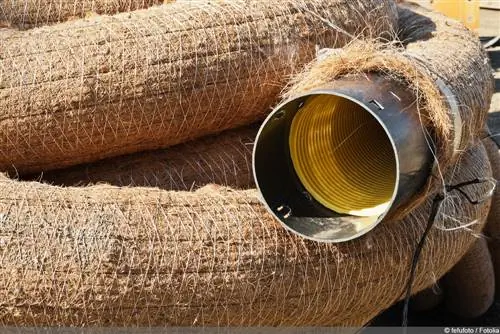
The inlet pipe can run both underground and above the surface of the earth. When laying underground, a corresponding channel must be laid from the starting point to the shaft in which the inlet pipe is located. In any case, it is important that the pipe supply has a slope towards the shaft so that the water flows and does not stand still or push back. Several inlets can be connected to the pipe leading to the shaft using so-called connecting pieces.
Close the shaft
Around a manhole ring with side holes and/or side water inlet, the outer cavity should be filled with gravel at least up to half of the manhole ring and at most up to the inlet pipe. The previously excavated earth is then filled in. In other versions, the entire cavity can be closed with earth.
If open shaft rings are used, as is usually the case with concrete rings, covers can be purchased to close the shaft system and, if necessary, cover it completely with soil, for example to sow lawn on it and make the septic tank invisible let.
Tip:
When planting above a shaft, it is important to pay attention to shallow and deep roots. Roots that extend deep into the ground can damage inlet pipes and, in the worst case, also the plastic manhole ring and/or the gravel drainage.

